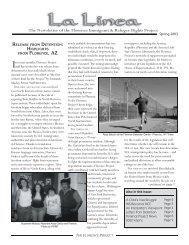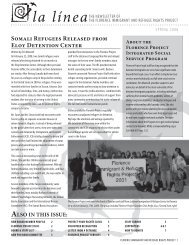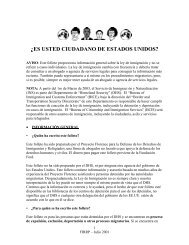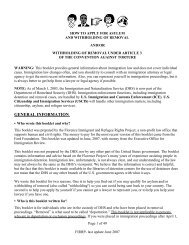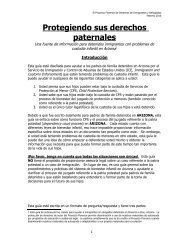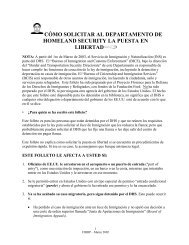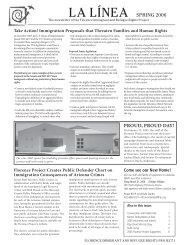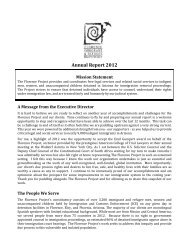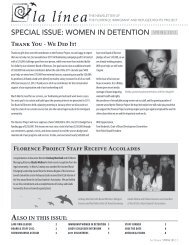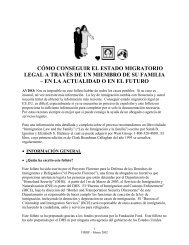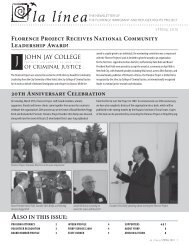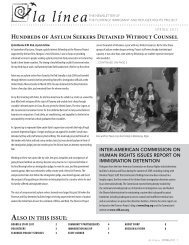quick reference chart and annotations for determining immigration ...
quick reference chart and annotations for determining immigration ...
quick reference chart and annotations for determining immigration ...
Create successful ePaper yourself
Turn your PDF publications into a flip-book with our unique Google optimized e-Paper software.
Immigrant Legal Resource Center, Florence Immigrant <strong>and</strong> Refugee Rights Project,<br />
Maricopa County Public Defender August 2012<br />
Non-consensual sex meets the test <strong>for</strong> “sexual abuse” because it is likely to be considered to<br />
cause emotional or physical harm to the victim. See discussion of “harm” test in United States v.<br />
Medina-Villa, 567 F.3d 507 (9th Cir. 2009). (Further, see discussion below of this offense as a crime of<br />
violence, deportable crime of child abuse <strong>and</strong> crime of domestic violence, <strong>and</strong> crime involving moral<br />
turpitude.)<br />
Regarding proof that the victim was a minor, it is likely that Arizona <strong>immigration</strong> judges will find<br />
that a record of conviction that specifies that the victim was under 18 will prove the victim was a minor.<br />
Earlier law held that if an offense requires only that the victim be over age 15, evidence in the record that<br />
the victim was some other specific age could not be considered. See, e.g., Estrada-Espinoza v. Mukasey,<br />
546 F.3d 1147 (9th Cir. 2008) (en banc), Rivera-Cuartas v. Holder, 605 F.3d 699 (9th Cir. 2010). In<br />
2011 the Ninth Circuit held that an IJ may consider a fact from the record of conviction that is not literally<br />
an element of the offense, as long as the fact is necessary to establish an element of the offense. United<br />
States v. Aguila-Montes de Oca, 655 F.3d 915 (9th Cir. 2011) (en banc), overruling in part Estrada-<br />
Espinoza, supra; see Practice Advisories on Aguila-Montes de Oca at www.ilrc.org/crimes. ICE will<br />
argue that because a statement of the victim’s specific age is necessary to establish that the age was over<br />
15, such evidence from the record can be considered. Immigration counsel will contest this <strong>and</strong> might<br />
win at the Ninth Circuit, but criminal defense counsel must assume that Arizona <strong>immigration</strong> judges will<br />
agree with ICE <strong>and</strong> that the defendant will be detained during any appeals. (Note that currently ICE is<br />
arguing that an <strong>immigration</strong> judge can consider a specific age of the victim set out in record, even where<br />
the statute of conviction has no element of age, so that the age of the victim would be necessary to prove<br />
an element of the offense. See discussion of ARS § 13-1405.)<br />
Consensual sexual conduct with a person under the age of 15, if the contact involves only the<br />
female breast. Criminal defense counsel must assume conservatively that this will be held to be sexual<br />
abuse of a minor. To preserve arguments against this in <strong>immigration</strong> proceedings, criminal defense<br />
counsel should have the record of conviction indicate that the victim was age 14, or at least not indicate<br />
that the victim was age 13 or younger.<br />
Immigration counsel will point out that while the Ninth Circuit has held that conduct with lewd<br />
intent with a person age 13 or younger is sexual abuse of a minor, <strong>and</strong> that conduct with lewd intent with<br />
a victim age 15 or older is not necessarily sexual abuse of a minor, the court has not ruled on the offense<br />
of sexual contact with a victim who is age 14 or 15. Compare, e.g., United States v. Baron-Medina, 187<br />
F.3d 1144, 1147 (9th Cir. 1999) (lewd act with a victim under age 14 is sexual abuse of a minor) with<br />
U.S. v. Castro, 607 F.3d 566, 567-58 (9th Cir. 2010) (lewd act with a 14- or 15-year old victim is not<br />
categorically SAM). In fact, the Ninth Circuit has held that even sexual intercourse with a 15-year-old is<br />
not necessarily sexual abuse. Pelayo-Garcia v. Holder, 589 F.3d 1010 (9th Cir. 2009) (sexual conduct<br />
with a person just under sixteen is not per se abusive). In light of that st<strong>and</strong>ard, <strong>immigration</strong> counsel will<br />
argue that touching the breast of a 14-year-old should not be held necessarily to be sexual abuse of a<br />
minor.<br />
The reasoning in these cases is as follows. Sexual contact with a person under age of 14 has been<br />
held to constitute sexual abuse of a minor on the grounds that using young children <strong>for</strong> sexual<br />
gratification is inherently abusive <strong>and</strong> harmful. United States v. Baron-Medina, 187 F.3d 1144, 1147 (9th<br />
Cir. 1999). The Ninth Circuit has recognized, however, that the older the teenager, the less likely it is that<br />
some <strong>for</strong>m of consensual contact will cause psychological harm. See United States v. Baza-Martinez,<br />
464 F.3d at 1015 (9th Cir. 2006) (noting that, under Baron-Medina, section 288(a) punishes "abuse"<br />
"because it requires use of young children, implying harmful or injurious conduct" (internal quotation<br />
marks omitted)); United States v. Lopez-Solis, 447 F.3d 1201, 1206 (9th Cir. 2006) ("The age affects<br />
Arizona Criminal Chart with Explanatory Endnote – August 2012<br />
37



